Modeling the Impacts of Land Reclamation on Sediment Dynamics in a Semi-Enclosed Bay
Abstract
:1. Introduction
2. Materials and Methods
2.1. Study Area
2.2. Model Description
2.3. Model Validation
2.4. Numerical Experiments
2.5. Calculation of Sediment Term
3. Results
3.1. Hydrodynamic Characteristics Change
3.1.1. Tidal Current
3.1.2. Subtidal Current
3.2. Responses of Suspended Sediment and Bed Thickness
3.3. Sediment Term Analysis
3.4. Volume and Sediment Transport
4. Discussion
4.1. Potential Mechanisms Controlling Sediment Transport
4.2. Implications
4.3. Limitations and Future Works
5. Conclusions
Author Contributions
Funding
Institutional Review Board Statement
Informed Consent Statement
Data Availability Statement
Acknowledgments
Conflicts of Interest
References
- Wang, W.; Liu, H.; Li, Y.; Su, J. Development and management of land reclamation in China. Ocean Coast. Manag. 2014, 102, 415–425. [Google Scholar] [CrossRef]
- Mentaschi, L.; Vousdoukas, M.I.; Pekel, J.F.; Voukouvalas, E.; Feyen, L. Global long-term observations of coastal erosion and accretion. Sci. Rep. 2018, 8, 12876. [Google Scholar] [CrossRef] [PubMed]
- Li, X.; Damen, M.C.J. Coastline change detection with satellite remote sensing for environmental management of the Pearl River Estuary, China. J. Mar. Syst. 2010, 82, S54–S61. [Google Scholar] [CrossRef]
- Okada, T.; Nakayama, K.; Takao, T.; Furukawa, K. Influence of freshwater input and bay reclamation on long-term changes in seawater residence times in Tokyo bay, Japan. Hydrol. Process. 2011, 25, 2694–2702. [Google Scholar] [CrossRef]
- van Maren, D.S.; Oost, A.P.; Wang, Z.B.; Vos, P.C. The effect of land reclamations and sediment extraction on the suspended sediment concentration in the Ems Estuary. Mar. Geol. 2016, 376, 147–157. [Google Scholar] [CrossRef]
- Cheng, Z.; Jalon-Rójas, I.; Wang, X.H.; Liu, Y. Impacts of land reclamation on sediment transport and sedimentary environment in a macro-tidal estuary. Estuar. Coast. Shelf Sci. 2020, 242, 106861. [Google Scholar] [CrossRef]
- Chen, P.; Sun, Z.; Zhou, X.; Xia, Y.; Li, L.; He, Z.; Wang, R.; Xie, H. Impacts of coastal reclamation on tidal and sediment dynamics in the Rui’an coast of China. Ocean Dyn. 2021, 71, 323–341. [Google Scholar] [CrossRef]
- Zhang, R.; Chen, Y.; Chen, P.; Zhou, X.; Wu, B.; Chen, K.; Sun, Z.; Yao, P. Impacts of tidal flat reclamation on suspended sediment dynamics in the tidal-dominated Wenzhou Coast, China. Front. Mar. Sci. 2023, 10, 1097177. [Google Scholar] [CrossRef]
- Van der Spek, A. Tidal asymmetry and long-term evolution of Holocene tidal basins in The Netherlands: Simulation of palaeo-tides in the Schelde estuary. Mar. Geol. 1997, 141, 71–90. [Google Scholar] [CrossRef]
- Williams, J.R.; Dellapenna, T.M.; Lee, G.-H. Shifts in depositional environments as a natural response to anthropogenic alterations: Nakdong Estuary, South Korea. Mar. Geol. 2013, 343, 47–61. [Google Scholar] [CrossRef]
- Williams, J.; Lee, G.-H.; Shin, H.-J.; Dellapenna, T. Mechanism for sediment convergence in the anthropogenically altered microtidal Nakdong Estuary, South Korea. Mar. Geol. 2015, 369, 79–90. [Google Scholar] [CrossRef]
- Vona, I.; Gray, M.; Nardin, W. The Impact of Submerged Breakwaters on Sediment Distribution along Marsh Boundaries. Water 2020, 12, 1016. [Google Scholar] [CrossRef]
- Lee, H.J.; Ryu, S.O. Changes in topography and surface sediments by the Saemangeum dyke in an estuarine complex, west coast of Korea. Cont. Shelf Res. 2008, 28, 1177–1189. [Google Scholar] [CrossRef]
- Liang, H.; Kuang, C.; Olabarrieta, M.; Song, H.; Ma, Y.; Dong, Z.; Han, X.; Zuo, L.; Liu, Y. Morphodynamic responses of Caofeidian channel-shoal system to sequential large-scale land reclamation. Cont. Shelf Res. 2018, 165, 12–25. [Google Scholar] [CrossRef]
- Cox, J.R.; Leuven, J.R.F.W.; Pierik, H.J.; van Egmond, M.; Kleinhans, M.G. Sediment deficit and morphological change of the Rhine–Meuse river mouth attributed to multi-millennial anthropogenic impacts. Cont. Shelf Res. 2022, 244, 104766. [Google Scholar] [CrossRef]
- Nnafie, A.; VanOyen, T.; DeMaerschalck, B.; vanderVegt, M.; Wegen, M.v.d. Estuarine Channel Evolution in Response to Closure of Secondary Basins: An Observational and Morphodynamic Modeling Study of the Western Scheldt Estuary. J. Geophys. Res. Earth Surf. 2018, 123, 167–186. [Google Scholar] [CrossRef]
- Byun, D.S.; Wang, X.H.; Holloway, P.E. Tidal characteristic adjustment due to dyke and seawall construction in the Mokpo Coastal Zone, Korea. Estuar. Coast. Shelf Sci. 2004, 59, 185–196. [Google Scholar] [CrossRef]
- Xu, Y.; Gao, H.; Wei, X.; Zhu, J. The Effects of Reclamation Activity and Yellow River Runoff on Coastline and Area of the Laizhou Bay, China. J. Ocean Univ. China 2021, 20, 729–739. [Google Scholar] [CrossRef]
- Liu, X.; Feng, X.; Liu, J. Hydrodynamic evolution characteristics of southwest Laizhou Bay under the effect of port construction. Mar. Sci. 2016, 40, 138–145, (In Chinese with English abstract). [Google Scholar]
- Nie, C.; Wu, Y.; Zhu, J.; Xu, Y.; Du, P.; Wang, H. Numerical study on hydrodynamic effects of coastline changes in southwestern Laizhou Bay. Mar. Environ. Sci. 2023, 42, 228–236, (In Chinese with English abstract). [Google Scholar]
- Lu, J.; Qiao, F.L.; Wang, X.H.; Wang, Y.G.; Teng, Y.; Xia, C.S. A numerical study of transport dynamics and seasonal variability of the Yellow River sediment in the Bohai and Yellow seas. Estuar. Coast. Shelf Sci. 2011, 95, 39–51. [Google Scholar] [CrossRef]
- Bian, C.; Jiang, W.; Greatbatch, R.J. An exploratory model study of sediment transport sources and deposits in the Bohai Sea, Yellow Sea, and East China Sea. J. Geophys. Res. Ocean. 2013, 118, 5908–5923. [Google Scholar] [CrossRef]
- Wang, C.; Liu, Z.; Harris, C.K.; Wu, X.; Wang, H.; Bian, C.; Bi, N.; Duan, H.; Xu, J. The Impact of Winter Storms on Sediment Transport Through a Narrow Strait, Bohai, China. J. Geophys. Res. Ocean. 2020, 125, e2020JC016069. [Google Scholar] [CrossRef]
- Wu, W.; Zhai, F.; Liu, C.; Gu, Y.; Li, P. Three-dimensional structure of summer circulation in the Bohai Sea and its intraseasonal variability. Ocean Dyn. 2023, 73, 679–698. [Google Scholar] [CrossRef]
- Li, Y.; Zhang, H.; Tang, C.; Zou, T.; Jiang, D. Influence of rising sea level on tidal dynamics in the Bohai Sea. J. Coast. Res. 2016, 74, 22–31. [Google Scholar] [CrossRef]
- Lv, X.; Yuan, D.; Ma, X.; Tao, J. Wave characteristics analysis in Bohai Sea based on ECMWF wind field. Ocean Eng. 2014, 91, 159–171. [Google Scholar] [CrossRef]
- Xie, B.; Bao, R.; Yin, D.; Zhu, L.; Hu, R.; Cai, W.; Liu, T.; Lin, C.; Lu, P. The spatio-temporal distribution and transport of suspended sediment in Laizhou Bay: Insights from hydrological and sedimentological investigations. Front. Earth Sci. 2022, 10, 994258. [Google Scholar] [CrossRef]
- Chen, C.; Qi, J.; Li, C.; Beardsley, R.C.; Lin, H.; Walker, R.; Gates, K. Complexity of the flooding/drying process in an estuarine tidal-creek salt-marsh system: An application of FVCOM. J. Geophys. Res. Ocean. 2008, 113, C07052. [Google Scholar] [CrossRef]
- Ge, J.; Shen, F.; Guo, W.; Chen, C.; Ding, P. Estimation of critical shear stress for erosion in the Changjiang Estuary: A synergy research of observation, GOCI sensing and modeling. J. Geophys. Res. Ocean. 2015, 120, 8439–8465. [Google Scholar] [CrossRef]
- Chen, C.; Gao, G.; Zhang, Y.; Beardsley, R.C.; Lai, Z.; Qi, J.; Lin, H. Circulation in the Arctic Ocean: Results from a high-resolution coupled ice-sea nested Global-FVCOM and Arctic-FVCOM system. Prog. Oceanogr. 2016, 141, 60–80. [Google Scholar] [CrossRef]
- Cong, S.; Wu, X.; Ge, J.; Bi, N.; Li, Y.; Lu, J.; Wang, H. Impact of Typhoon Chan-hom on sediment dynamics and morphological changes on the East China Sea inner shelf. Mar. Geol. 2021, 440, 106578. [Google Scholar] [CrossRef]
- Jeong, J.-S.; Woo, S.-B.; Lee, H.S.; Gu, B.-H.; Kim, J.W.; Song, J.I. Baroclinic Effect on Inner-Port Circulation in a Macro-Tidal Estuary: A Case Study of Incheon North Port, Korea. J. Mar. Sci. Eng. 2022, 10, 392. [Google Scholar] [CrossRef]
- Deb, M.; Kirby, J.T.; Abdolali, A.; Shi, F. A surface porosity approach for eliminating artificial ponding in coastal salt marsh simulations. Coast. Eng. 2023, 179, 104246. [Google Scholar] [CrossRef]
- Zhong, Y.; Zhang, J.; Song, D.; Zhao, Y.; Liu, Y.; Wu, W.; Qiao, L. Numerical study of hydrodynamic effects on Manila clam population distribution and transport in the Southwest Laizhou Bay, China. Sci Total Env. 2023, 865, 161214. [Google Scholar] [CrossRef] [PubMed]
- Tang, B.; Zhang, F.; Jia, J.; Feng, Z.; Tang, J.; Xing, F.; Wang, Y.P. The Role of Tropical Cyclone on Changjiang River Subaqueous Delta Geomorphology: A Numerical Investigation of Tropical Cyclone Danas (2019). J. Geophys. Res. Ocean. 2023, 128, e2022JC019190. [Google Scholar] [CrossRef]
- Booij, N.; Ris, R.C.; Holthuijsen, L.H. A third-generation wave model for coastal regions: 1. Model description and validation. J. Geophys. Res. Ocean. 1999, 104, 7649–7666. [Google Scholar] [CrossRef]
- Rusu, L.; Guedes Soares, C. Modelling the wave–current interactions in an offshore basin using the SWAN model. Ocean Eng. 2011, 38, 63–76. [Google Scholar] [CrossRef]
- Suzuki, T.; Zijlema, M.; Burger, B.; Meijer, M.C.; Narayan, S. Wave dissipation by vegetation with layer schematization in SWAN. Coast. Eng. 2012, 59, 64–71. [Google Scholar] [CrossRef]
- Amarouche, K.; Akpınar, A.; Bachari, N.E.I.; Çakmak, R.E.; Houma, F. Evaluation of a high-resolution wave hindcast model SWAN for the West Mediterranean basin. Appl. Ocean Res. 2019, 84, 225–241. [Google Scholar] [CrossRef]
- Abu Zed, A.A.; Kansoh, R.M.; Iskander, M.M.; Elkholy, M. Wind and wave climate southeastern of the Mediterranean Sea based on a high-resolution SWAN model. Dyn. Atmos. Ocean. 2022, 99, 101311. [Google Scholar] [CrossRef]
- Zhang, W.; Zhao, H.; Chen, G.; Yang, J. Assessing the performance of SWAN model for wave simulations in the Bay of Bengal. Ocean Eng. 2023, 285, 115295. [Google Scholar] [CrossRef]
- Rogers, W.E.; Hwang, P.A.; Wang, D.W. Investigation of wave growth and decay in the SWAN model: Three regional-scale applications. J. Phys. Oceanogr. 2003, 33, 366–389. [Google Scholar] [CrossRef]
- Zhong, Y.; Qiao, L.; Song, D.; Ding, Y.; Xu, J.; Xue, W.; Xue, C. Impact of cold water mass on suspended sediment transport in the South Yellow Sea. Mar. Geol. 2020, 428, 106244. [Google Scholar] [CrossRef]
- Zhou, F.; Huang, D.; Xue, H.; Xuan, J.; Yan, T.; Ni, X.; Zeng, D.; Li, J. Circulations associated with cold pools in the Bohai Sea on the Chinese continental shelf. Cont. Shelf Res. 2017, 137, 25–38. [Google Scholar] [CrossRef]
- Mou, L.; Niu, Q.; Xia, M. The roles of wind and baroclinic processes in cross-isobath water exchange within the Bohai Sea. Estuar. Coast. Shelf Sci. 2022, 274, 107944. [Google Scholar] [CrossRef]
- Yang, Z.; Ji, Y.; Bi, N.; Lei, K.; Wang, H. Sediment transport off the Huanghe (Yellow River) delta and in the adjacent Bohai Sea in winter and seasonal comparison. Estuar. Coast. Shelf Sci. 2011, 93, 173–181. [Google Scholar] [CrossRef]
- Jia, Y.; Zhang, L.; Zheng, J.; Liu, X.; Jeng, D.-S.; Shan, H. Effects of wave-induced seabed liquefaction on sediment re-suspension in the Yellow River Delta. Ocean Eng. 2014, 89, 146–156. [Google Scholar] [CrossRef]
- Li, P.; Chen, S.; Ji, H.; Ke, Y.; Fu, Y. Combining Landsat-8 and Sentinel-2 to investigate seasonal changes of suspended particulate matter off the abandoned distributary mouths of Yellow River Delta. Mar. Geol. 2021, 441, 106622. [Google Scholar] [CrossRef]
- Zhu, Z.; Du, X.; Liang, B.; Wang, L.; Song, Y.; Li, P.; Fan, Y.; Bian, S.; Wang, Y.; Zhang, Y.; et al. Simulating liquefaction-induced resuspension flux in a sediment transport model. Water Res 2024, 261, 122057. [Google Scholar] [CrossRef]
- Qin, Y.-C.; Mei, X.; Jiang, X.; Luan, X.; Zhou, L.; Zhu, X. Sediment provenance and tidal current-driven recycling of Yellow River detritus in the Bohai Sea, China. Mar. Geol. 2021, 436, 106473. [Google Scholar] [CrossRef]
- Blondeaux, P.; Vittori, G. Flow and sediment transport induced by tide propagation: 1. The flat bottom case. J. Geophys. Res. Ocean. 2005, 110, C07020. [Google Scholar] [CrossRef]
- Bever, A.J.; MacWilliams, M.L. Simulating sediment transport processes in San Pablo Bay using coupled hydrodynamic, wave, and sediment transport models. Mar. Geol. 2013, 345, 235–253. [Google Scholar] [CrossRef]
- Luo, Z.; Zhu, J.; Wu, H.; Li, X. Dynamics of the Sediment Plume Over the Yangtze Bank in the Yellow and East China Seas. J. Geophys. Res. Ocean. 2017, 122, 10073–10090. [Google Scholar] [CrossRef]
- Scully, M.E.; Friedrichs, C.T. Sediment pumping by tidal asymmetry in a partially mixed estuary. J. Geophys. Res. Ocean. 2007, 112, C07028. [Google Scholar] [CrossRef]
- Becherer, J.; Flöser, G.; Umlauf, L.; Burchard, H. Estuarine circulation versus tidal pumping: Sediment transport in a well-mixed tidal inlet. J. Geophys. Res. Ocean. 2016, 121, 6251–6270. [Google Scholar] [CrossRef]
- Kim, S.I.; Seo, J.Y.; Park, J.-H.; Kim, P.J.; Kim, I.G.; Kim, K.M.; Ha, H.K. Imbalance of sediment transport in a meso-tidal bay: Effect of tidal pumping and residual circulation. Front. Mar. Sci. 2024, 11, 1362583. [Google Scholar] [CrossRef]
- Noss, C.; Lorke, A. Roughness, resistance, and dispersion: Relationships in small streams. Water Resour. Res. 2016, 52, 2802–2821. [Google Scholar] [CrossRef]
- Dyakonova, T.; Khoperskov, A. Bottom friction models for shallow water equations: Manning’s roughness coefficient and small-scale bottom heterogeneity. J. Phys. Conf. Ser. 2018, 973, 012032. [Google Scholar] [CrossRef]
- Rivière, P.; Treguier, A.M.; Klein, P. Effects of bottom friction on nonlinear equilibration of an oceanic baroclinic jet. J. Phys. Oceanogr. 2004, 34, 416–432. [Google Scholar] [CrossRef]
- Qiao, L.; Zhong, Y.; Wang, N.; Zhao, K.; Huang, L.; Wang, Z. Seasonal transportation and deposition of the suspended sediments in the Bohai Sea and Yellow Sea and the related mechanisms. Ocean Dyn. 2016, 66, 751–766. [Google Scholar] [CrossRef]
- Liu, X.; Qiao, L.; Li, G.; Zhong, Y.; Miao, H.; Hu, R. Discontinuity of sediment transport from the Bohai Sea to the open sea dominated by the wind direction. Estuar. Coast. Shelf Sci. 2023, 293, 108486. [Google Scholar] [CrossRef]


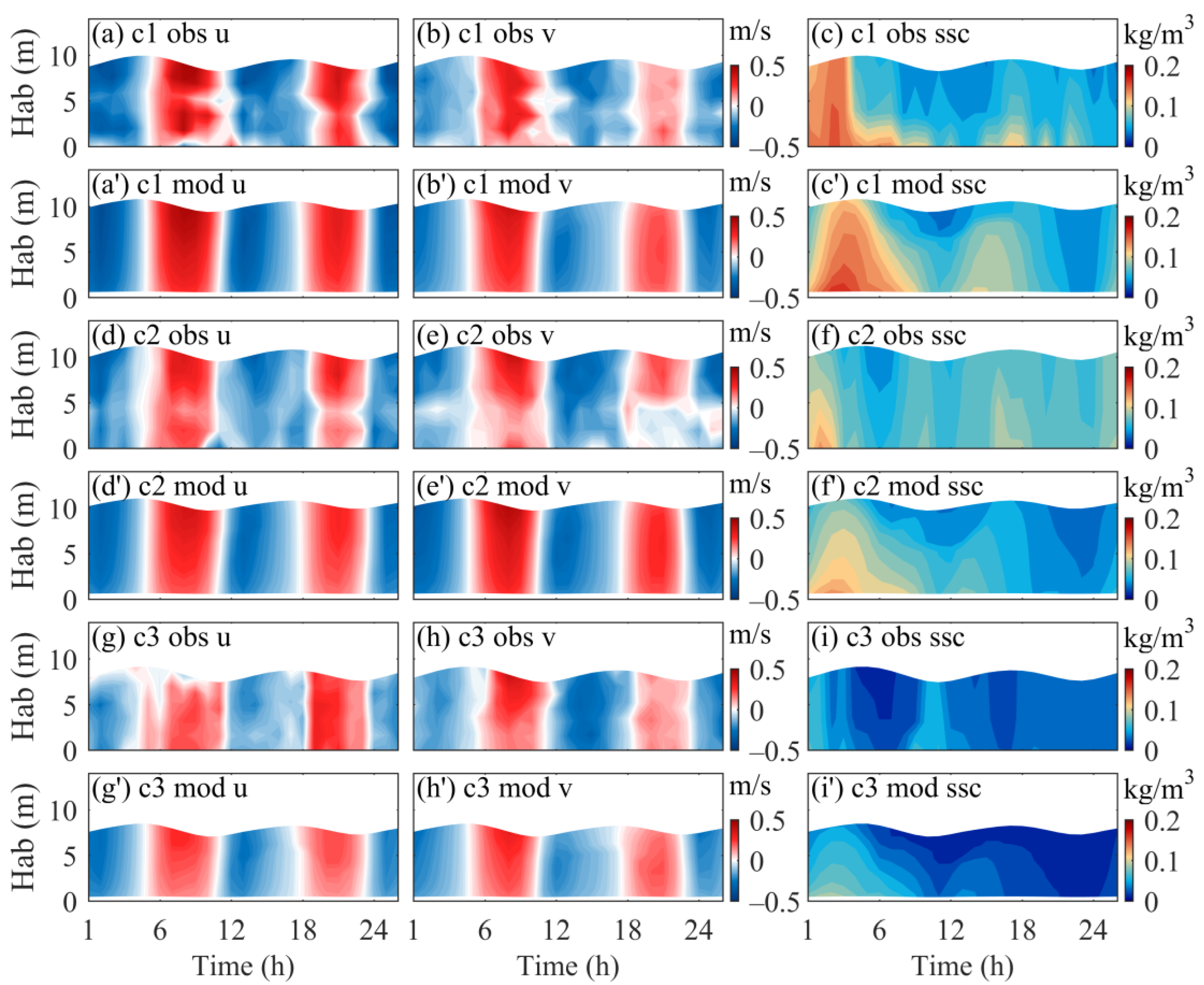
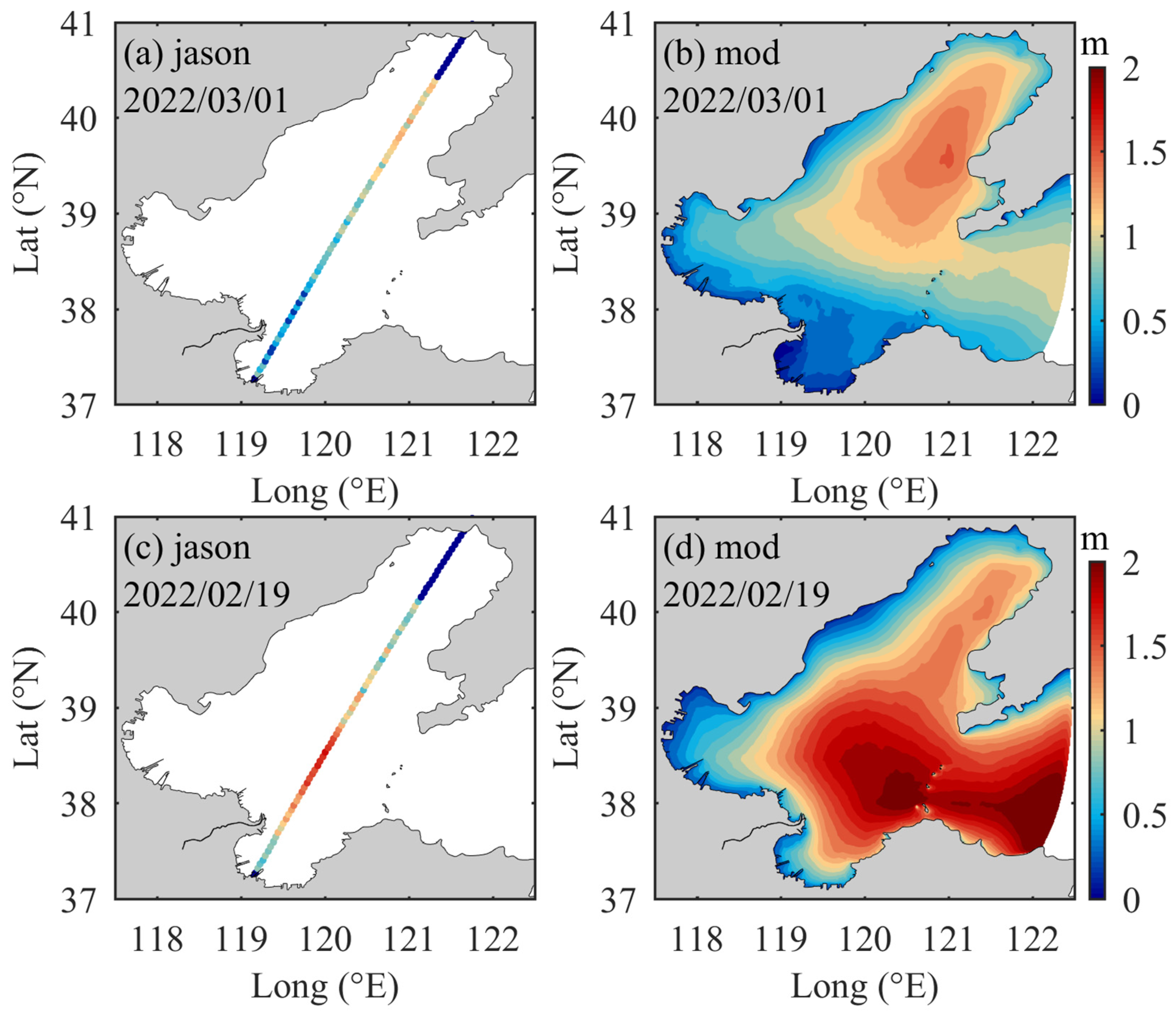
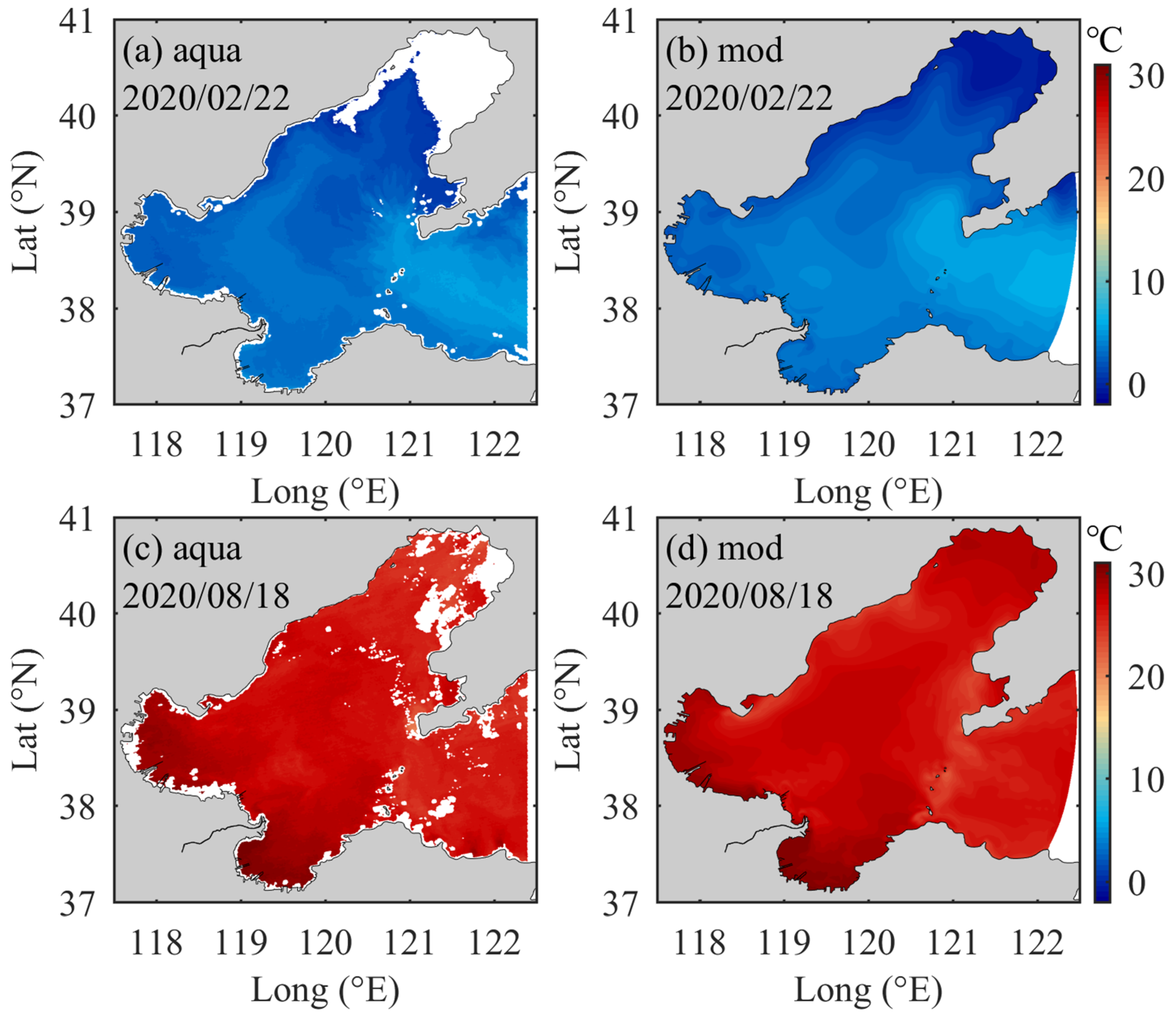
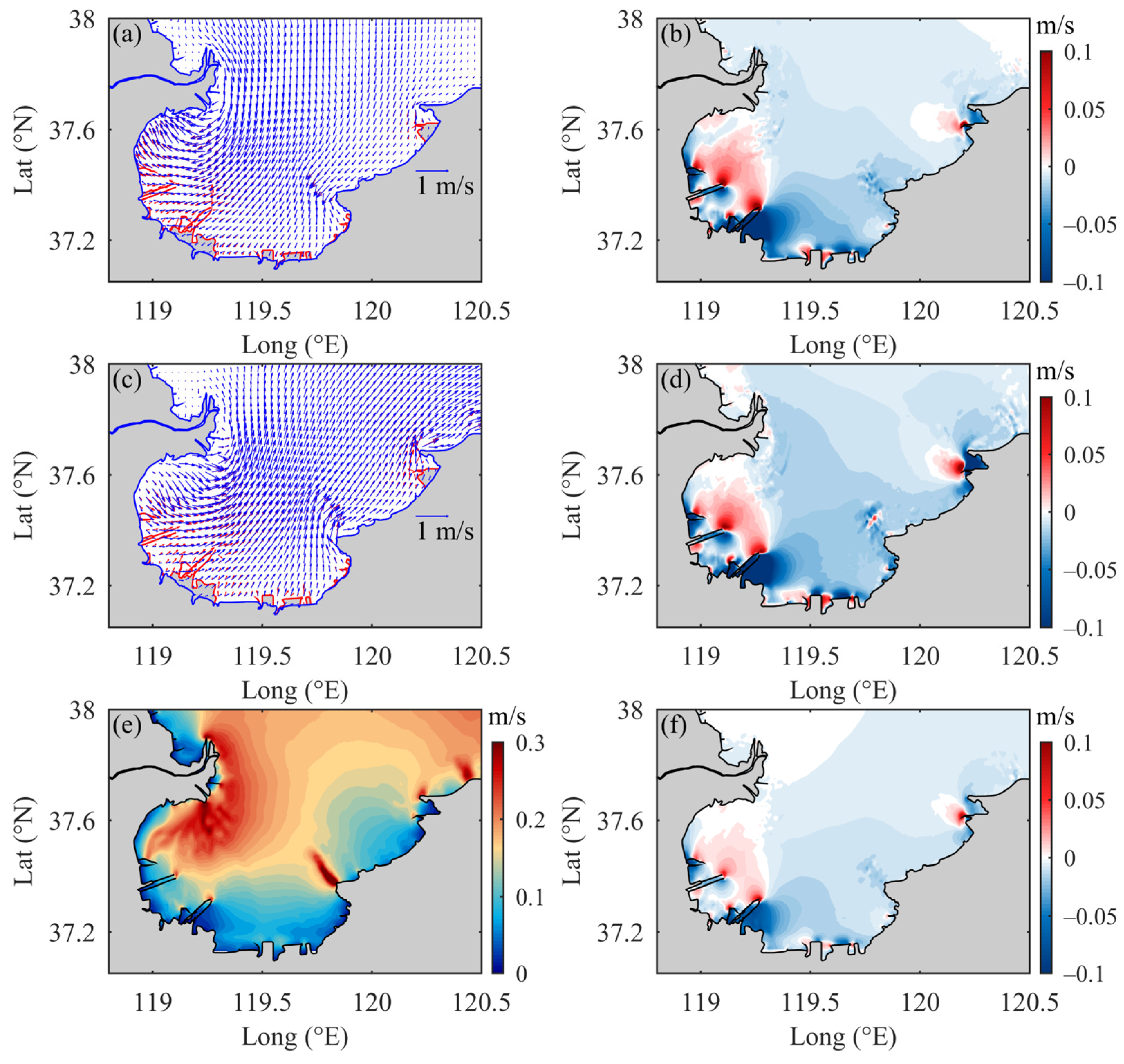

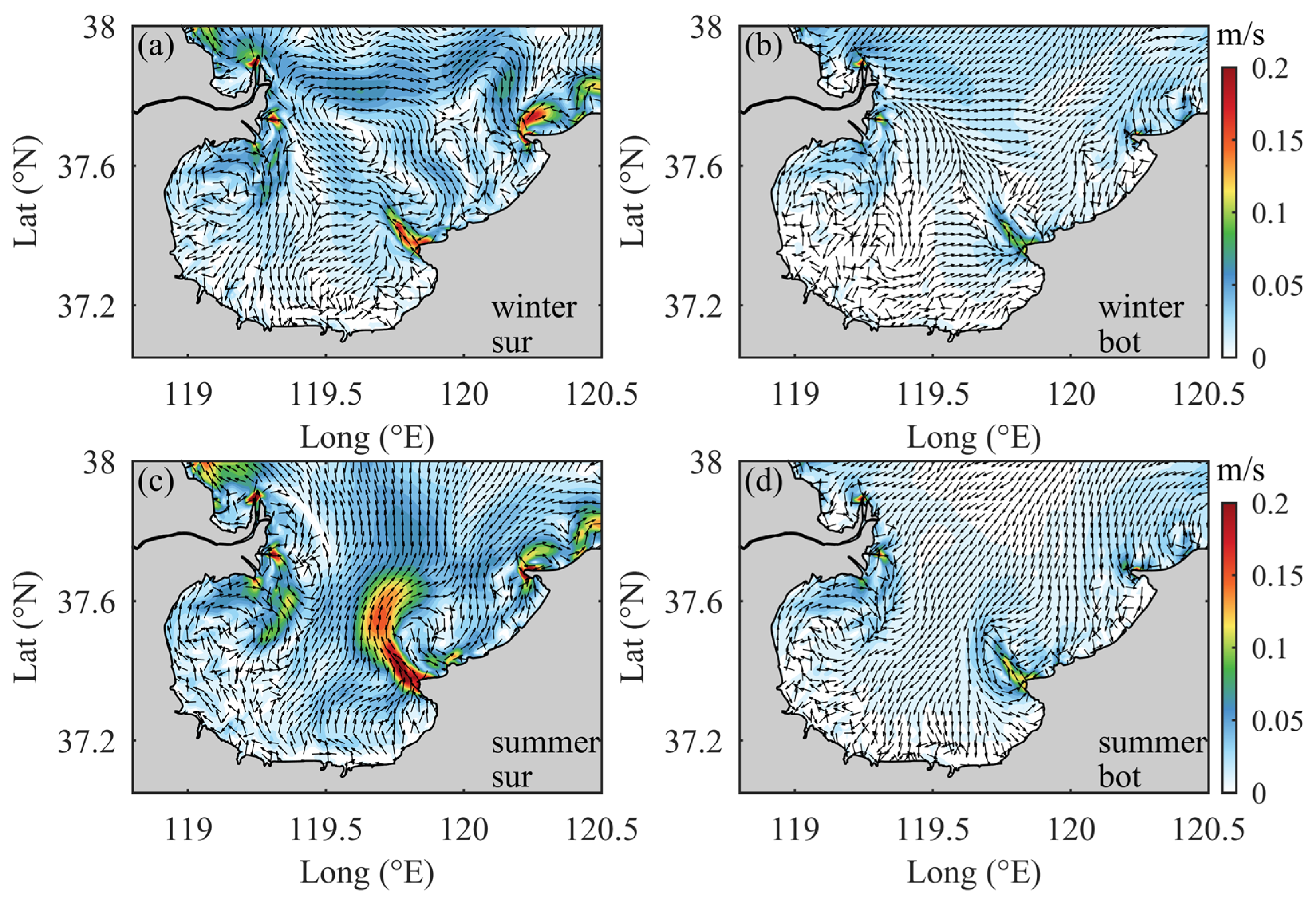
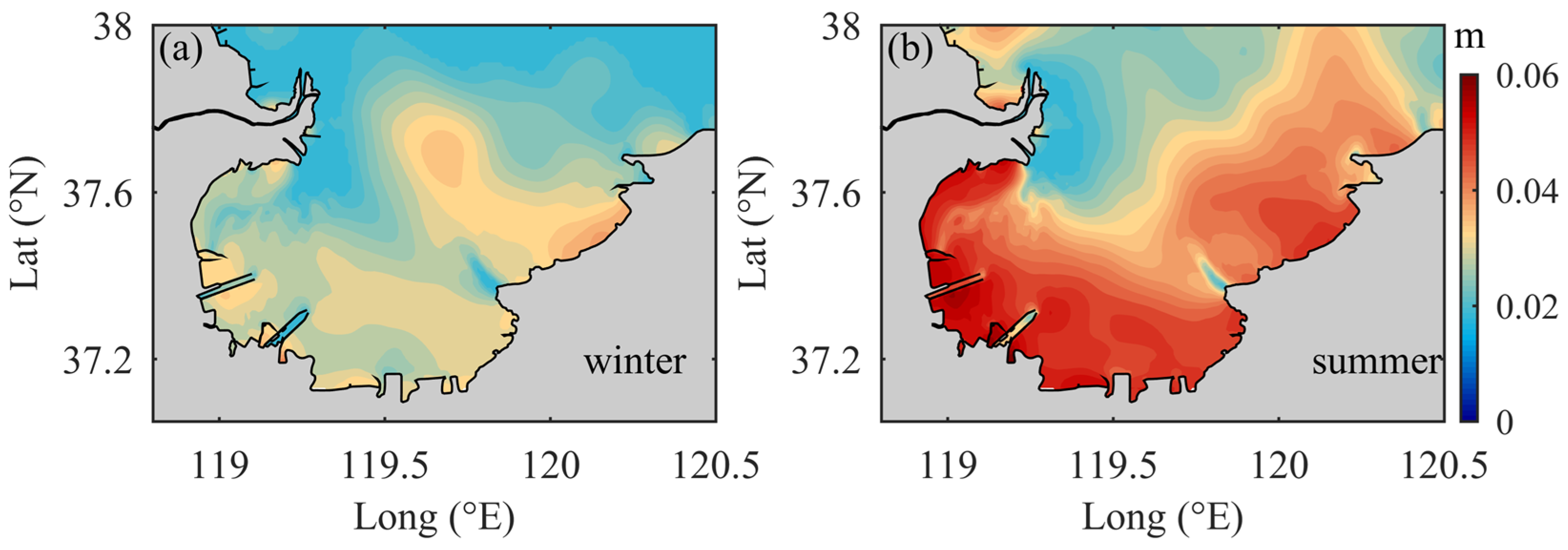
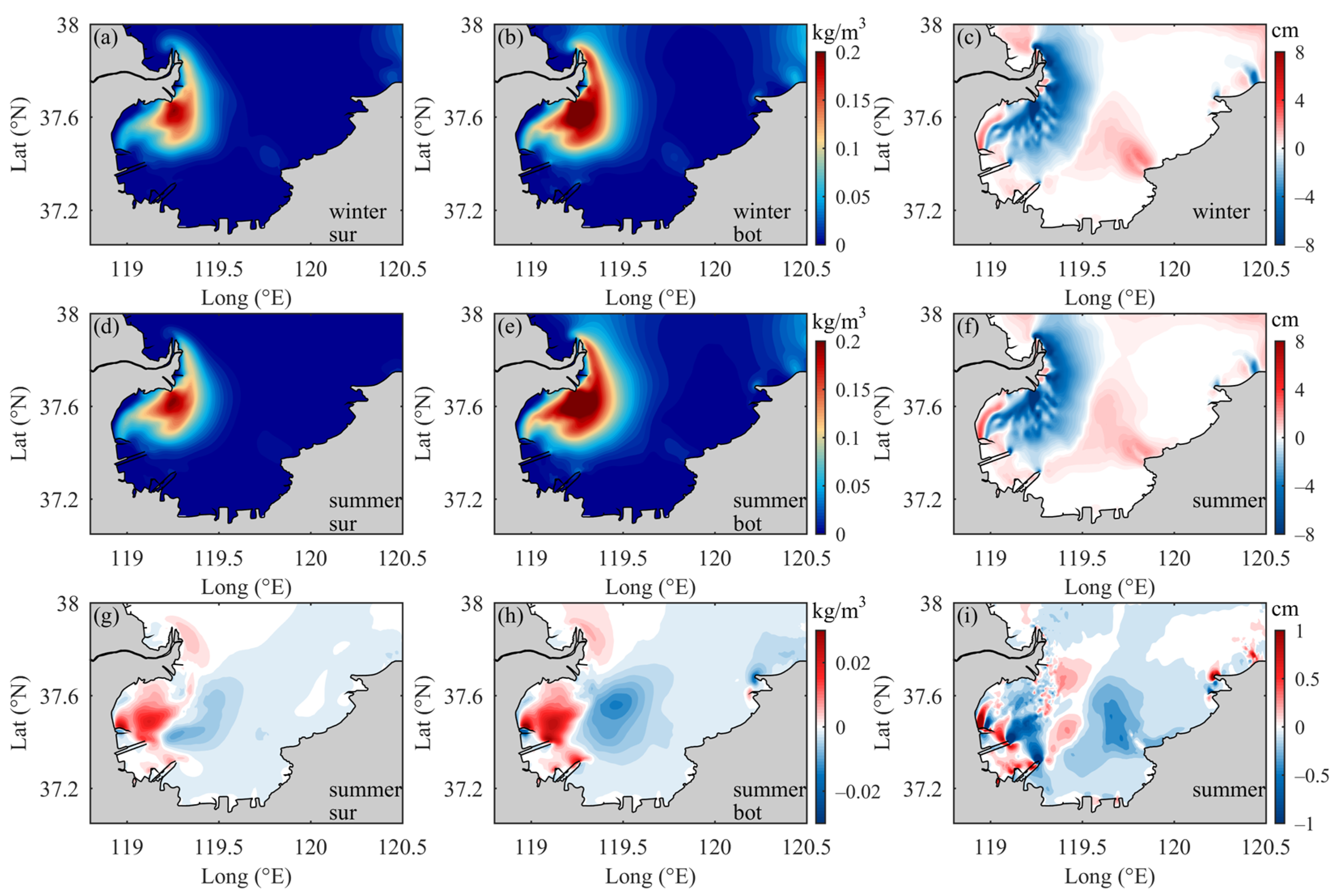
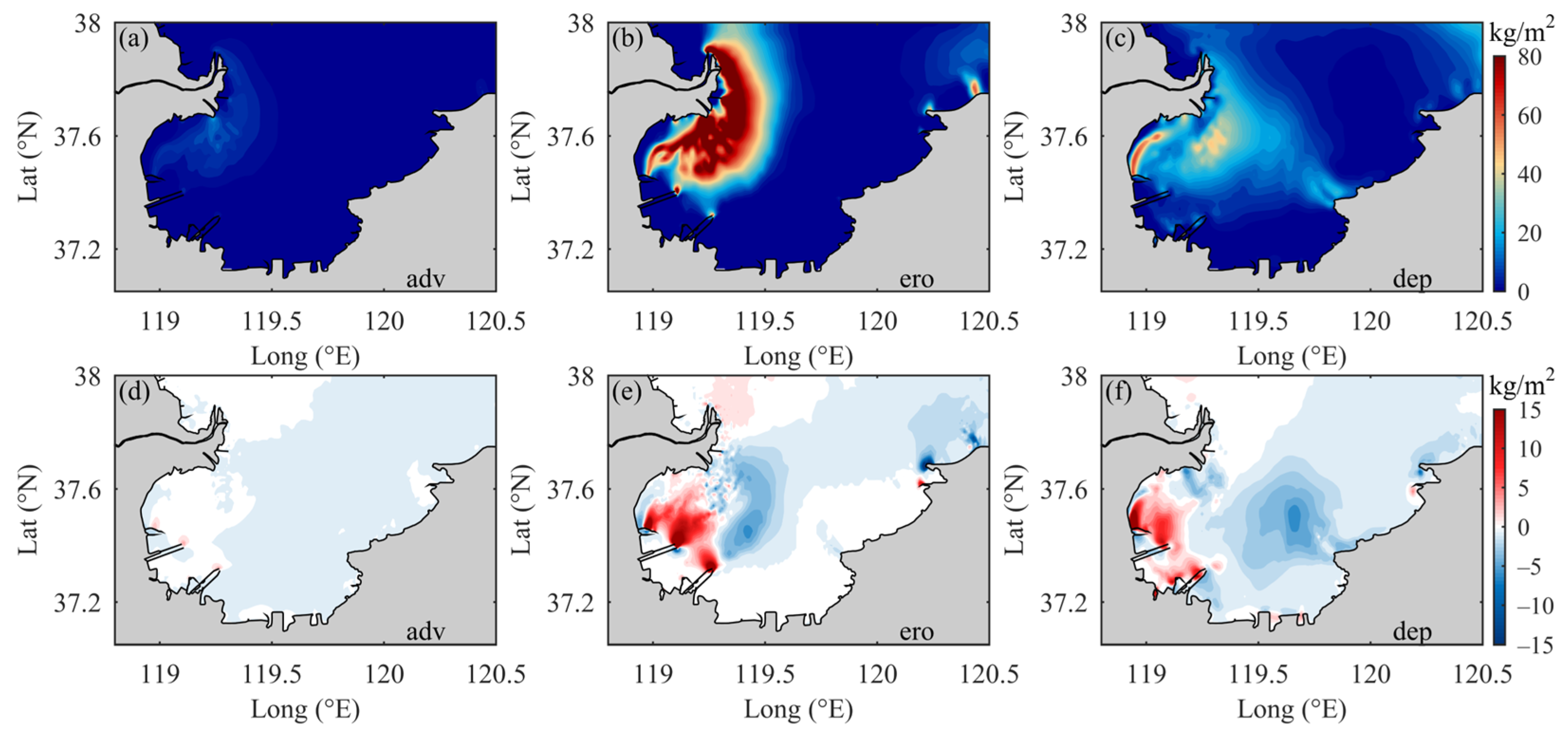
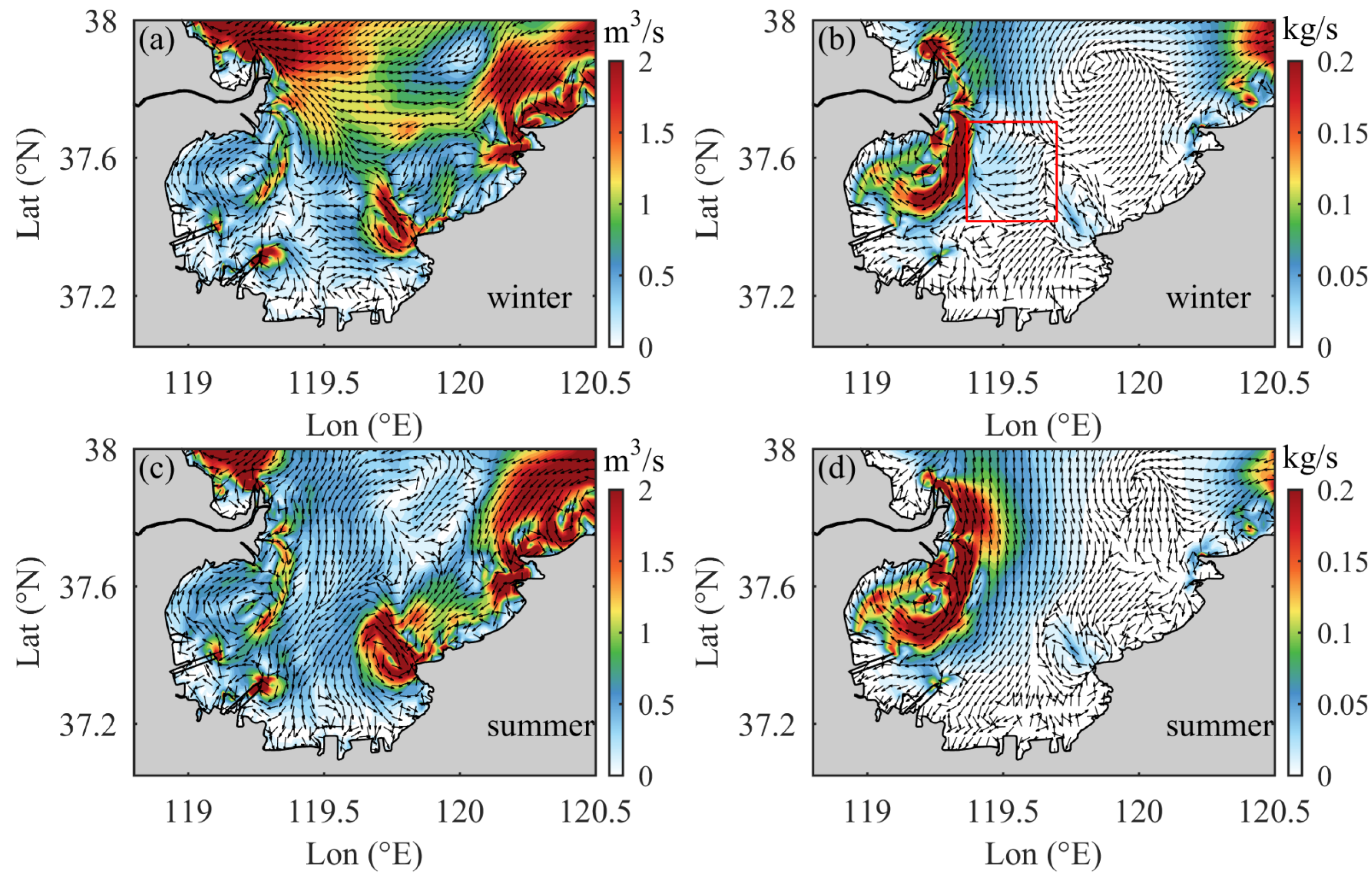
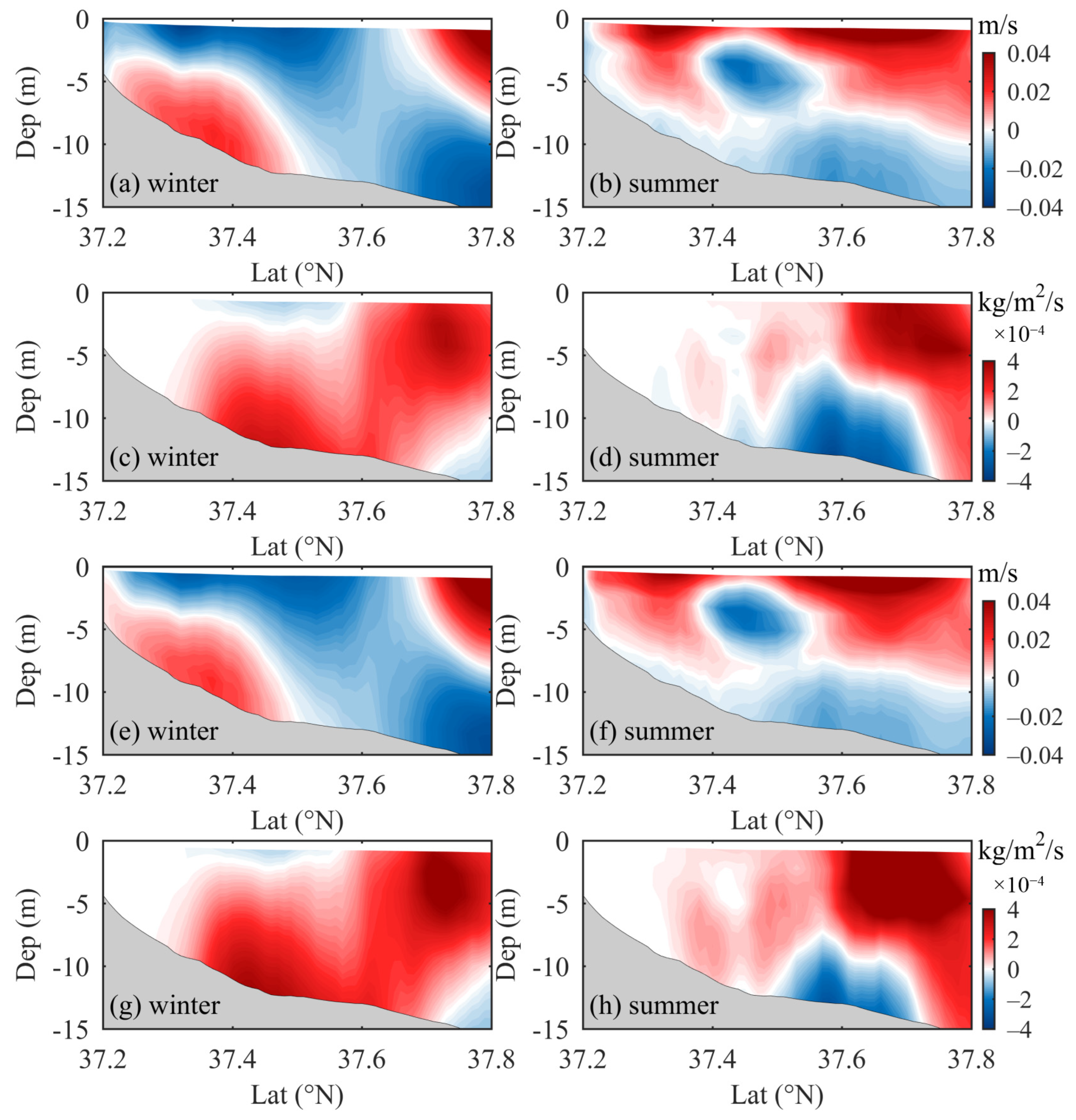
| Parameter | Clay | Silt | Sand |
|---|---|---|---|
| Median grain size (mm) | 0.004 | 0.02 | 0.25 |
| Density (kg/m3) | 2650 | 2650 | 2650 |
| Settling velocity (mm/s) | 0.03 | 0.60 | 1.30 |
| Erosion rate (kg/m2/s) | 7 × 10−5 | 7 × 10−5 | 7 × 10−5 |
| Critical shear stress (N/m2) | 0.23 | 0.09 | 1.30 |
| Porosity (%) | 0.50 | 0.45 | 0.30 |
| Parameter | c1 | c2 | c3 | ||||||
|---|---|---|---|---|---|---|---|---|---|
| R2 | RMSE | SS | R2 | RMSE | SS | R2 | RMSE | SS | |
| U | 0.96 | 0.08 | 0.85 | 0.95 | 0.07 | 0.83 | 0.89 | 0.08 | 0.73 |
| V | 0.90 | 0.08 | 0.64 | 0.93 | 0.10 | 0.45 | 0.84 | 0.09 | 0.68 |
| SSC | 0.74 | 0.02 | 0.45 | 0.71 | 0.02 | 0.42 | 0.59 | 0.02 | 0.31 |
| Numerical Experiments | Winter | Summer |
|---|---|---|
| Before reclamation | 510.98 | 208.97 |
| After reclamation | 397.69 | −30.20 |
Disclaimer/Publisher’s Note: The statements, opinions and data contained in all publications are solely those of the individual author(s) and contributor(s) and not of MDPI and/or the editor(s). MDPI and/or the editor(s) disclaim responsibility for any injury to people or property resulting from any ideas, methods, instructions or products referred to in the content. |
© 2024 by the authors. Licensee MDPI, Basel, Switzerland. This article is an open access article distributed under the terms and conditions of the Creative Commons Attribution (CC BY) license (https://creativecommons.org/licenses/by/4.0/).
Share and Cite
Zhong, Y.; Du, J.; Wang, Y.; Li, P.; Xu, G.; Miu, H.; Zhang, P.; Jiang, S.; Gao, W. Modeling the Impacts of Land Reclamation on Sediment Dynamics in a Semi-Enclosed Bay. J. Mar. Sci. Eng. 2024, 12, 1633. https://doi.org/10.3390/jmse12091633
Zhong Y, Du J, Wang Y, Li P, Xu G, Miu H, Zhang P, Jiang S, Gao W. Modeling the Impacts of Land Reclamation on Sediment Dynamics in a Semi-Enclosed Bay. Journal of Marine Science and Engineering. 2024; 12(9):1633. https://doi.org/10.3390/jmse12091633
Chicago/Turabian StyleZhong, Yi, Jun Du, Yongzhi Wang, Ping Li, Guoqiang Xu, Hongbin Miu, Peiyu Zhang, Shenghui Jiang, and Wei Gao. 2024. "Modeling the Impacts of Land Reclamation on Sediment Dynamics in a Semi-Enclosed Bay" Journal of Marine Science and Engineering 12, no. 9: 1633. https://doi.org/10.3390/jmse12091633
APA StyleZhong, Y., Du, J., Wang, Y., Li, P., Xu, G., Miu, H., Zhang, P., Jiang, S., & Gao, W. (2024). Modeling the Impacts of Land Reclamation on Sediment Dynamics in a Semi-Enclosed Bay. Journal of Marine Science and Engineering, 12(9), 1633. https://doi.org/10.3390/jmse12091633






